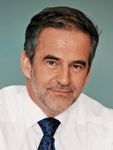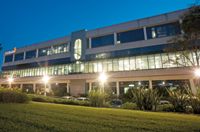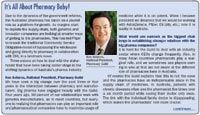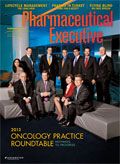Country Report: Australia
In some ways the Australian medicines industry is going through the same restructuring and challenges as the industry is globally: the country is dealing with patent cliffs, companies are cutting back staff, an ageing population forces the government to rethink healthcare expenditures, and big originator companies are reforming.
This sponsored supplement was produced by Focus Reports.
In some ways the Australian medicines industry is going through the same restructuring and challenges as the industry is globally: the country is dealing with patent cliffs, companies are cutting back staff, an ageing population forces the government to rethink healthcare expenditures, and big originator companies are reforming. And just like internationally, that is forcing the industry to rethink traditional ways of doing things. Only, the Australian pharmaceutical industry has been rethinking its role in such an innovative way that it is slowly floating from down under to the center of attention of the global industry.

A young female client of the Adult Mental Health Rehabilitation Unit at Sunshine Hospital, Victoria, Australia, Courtesy of Janssen-Cilag
During a visit to Australia in February 2012 Sir Andrew Witty, then still in his tenure as CEO of GlaxoSmithKline, quoted the Australian industry as an example of how the global industry should modernize itself and win back society's belief in its readiness to change, "whether that is through employment, contribution to savings, or delivery of remarkable medicines."
And indeed the Australian pharmaceutical industry is undergoing several remarkable developments. Its pharmaceutical manufacturing industry, not too long ago having been seemingly doomed to disappear as rationalization reigned, is reinventing itself as a high value added manufacturing hub. With USD4.19 billion it is now Australia's biggest exporting industry, before the car and wine industry, the country's traditional export strongholds.

Mark Fladrich, Managing Director, AstraZeneca
AstraZeneca, for instance, recently decided to invest USD80 million in its existing Australian production capabilities to provide the Chinese market with its asthma treatment medicine.
"For many lower value added manufacturing processes decisions are made every day to move manufacturing to India as an alternative to producing in Europe or Australia," AstraZeneca's managing director Mark Fladrich said. "The opportunity for AstraZeneca here is that technology that is used to support our medicines is complicated," he continued.

Dr. Brendan Shaw, Chief Executive, Medicines Australia
Furthermore, the notion of a disconnect between the country's research capabilities and big pharma's research investments, oft-heard when Focus Reports first visited Australia in 2008, is quickly turning obsolete. While big pharma mainly tended to focus on leveraging Australia's clinical research capabilities in the past, today the world's innovative companies are roaming Australia's research institutes and its Melbourne-based biotech industry to find ammunition for their pipelines. In 2012, the combined worth of Australia's publicly listed biomedical companies was actually higher on a per capita basis than is the case for such companies in the US, according to Mark Metherell, health correspondent of the Sydney Morning Herald.

AstraZeneca manufacturing plant in North Ryde, Australia
"The pharmaceutical industry is high-skilled, high-wage, high-tech, export- and innovation- oriented, low carbon footprint industry," said Dr. Brendan Shaw, Chief Executive of Medicines Australia, the association representing the discovery-driven pharmaceutical industry in Australia. "On top of that Australia has a fantastic base of medical research, public infrastructure, hospitals, universities that national and international companies can plug into."
These promising developments led Medicines Australia to unfold a highly ambitious agenda. The vision is to double the manufacturing output from AUD7 billion (USD7.34 billion) in 2012 to AUD14 billion (USD14.68 billion) over the next decade and to establish a number of highly specialised bio-manufacturing plants, to double exports from AUD4 billion (USD4.19 billion) to AUD8 billion (USD8.39 billion); and to double R&D investment from AUD1 billion (USD1.05 billion) to AUD2 billion (USD2.1 billion), to create many more high-skilled jobs and increase the number of Australians accessing clinical trials to 30,000.

Professor Warwick Anderson, CEO, NHMRC
Some doubt, however, whether the nation is sufficiently aware of the value of this highly innovative industry to generate the support needed to realize these plans. Making the importance of the industry clear can be especially challenging against the backdrop of a massive natural resource-driven economic boom that made Australian per capita GNP overtake the US' in 2011 (USD49.130 for Australia and USD48.620 for the US) according to World Bank data. This led the International Monetary Fund in April 2012 to predict that Australia would be the best performing major advanced economy in the world over the next two years.

Robert Hendriks, Managing Director, Genzyme
"We need to keep our policy makers understanding that booms in minerals and coals come and go; we need to balance that with industries built on brains, and the Australian medicines industry has shown that it can fulfill a balancing role," said professor Warwick Anderson, CEO of the National Health and Medical Research Council (NHMRC), Australia's medical research-funding organ that is responsible for handing out AUD0.8 billion in subsidies in 2012.
Paradoxically, today's biggest challenge to Australia's pharmaceutical industry indirectly comes from the nation's rapidly ageing population. The Australian government is looking to contain soaring health expenditures through reform of its pharmaceutical reimbursement system.
A DOUBLE-EDGED SWORD NAMED PBS
In the case of Australia, the reforms of this reimbursement system, the Pharmaceutical Benefits Scheme (PBS), have been about control of the supply chain to combine a rise in generics share with a drop in its prices in order to create headspace for reimbursement of new innovative medicines. Whether the PBS reforms are reaching their goals is up for serious debate. Many industry players are asking whether the government can afford to use the efficiencies that it has gained from generics to increase spending on new products.

Albert Spanos, General Manager, Celgene Australia
One of the industry representatives that questions the reforms is Robert Hendriks, managing director of Genzyme. "Statistics of PBS approvals of innovative medicines show that a decreasing percentage of submissions are approved. The central question today is: should the focus be on cost containment to the extent we see today, or should the focus shift more towards assessing real health outcomes?"

Preventing Beats Curing
Genzyme encounters a specific reimbursement challenge with its rare disease portfolio, for which it has to apply to obtain reimbursement on the life-saving drug program. The life-saving drug program gives a set of criteria, one of which is showing substantial life-saving benefit. This is extremely difficult for products that treat rare diseases: "we treat few patients, which makes it difficult to set up clinical trials, certainly when they are life-saving," said Hendriks. "Is it ethical to have a double blind randomized placebo-controlled trial? You might consider that at the beginning of the development of your drug, but if you are further down the path and clinicians are convinced that your drug works, how are you going to set up a trial that would allow patients to shorten their life-span?"
Such hard-to-meet standards across Australia's reimbursement programs could even put future investments of research-driven pharmaceutical companies at risk, thinks Hendriks. "I sincerely hope that government understands the harm it does to Australia's image as an attractive investment destination in the eyes of the global pharmaceutical industry," Hendriks said.

Dr. Suzanne Hill, Chair, Pharmaceutical Benefits Advisory Committee
Already, job losses of Medicines Australia-members in 2012 number around 300 on a total of 14.000 employees, with five major companies affected: Sanofi, Pfizer, MSD Australia, Eli Lilly and GlaxoSmithKline. The redundancies are considered to be related in part to medicines coming off patent and in part to price cuts that resulted from the latest PBS reform.
"Whilst the stated aims of PBS reforms related to efficient generics pricing and transparency to ensure cost-effective pricing are well on the way to being realised, the structural reforms related to serving the future needs of patients with the introduction of new innovative medicines still leave much room for improvement," said Albert Spanos, general manager of Celgene Australia, "both from a pricing and timing perspective, which is definitely having a material impact on industry investment in Australia, illustrated by the loss of 300 industry jobs in 2012."
In a response to industry criticism, Dr. Suzanne Hill, chair of the Pharmaceutical Benefits Advisory Committee (PBAC), the statutory committee that advises the Ministry of Health and Ageing as to what drugs will be listed on the PBS, explained how the reforms are changing the demands to the industry. "It is going to be demanding of the industry, because they will have to put a lot of effort into clinical trials that actually show that their products are really better, and that difference in efficacy or effectiveness can be translated into a difference in price," Dr. Hill said, adding that "The usual drug development by industry is incremental in its gains and development, and that is going to be a real challenge."
Looking at the growth of expenditure through the PBS, about one percent in an economy growing 3.2 percent in 2011, the reforms already seem to have the intended effect. Nonetheless, the end is not in sight. "I suspect that the government is going to look for a lot more savings before it allows more expenditure," said Dr. Hill.
AND THE KEY TO SUCCESS IS…
In this environment—"one of the most demanding in the world when it comes to data, cost-effectiveness proof, etc.", according Veronique Toully, managing director of UCB Australia and former vice-president in charge of pricing & reimbursement—a player's competitiveness is determined by several factors.

Veronique Toully, Managing Director, UCB Australia
"The companies that have had loss of exclusivity issues, a concentrated portfolio, and do not have a strong pipeline are really struggling," said Andy Jackson, general manager IMS Australia and New Zealand. "Those three dynamics together all hitting in one go plus a relatively unfavorable economic environment provide serious challenges."

Andy Jackson, Managing Director, IMS Australia
"Still, there are companies that are growing very well in this market, mainly companies with a specialist portfolio or from generics," according to Jackson. One example of a company that is doing well in the changing environment is Novartis. Recently appointed country head and managing director Jason Smith is confident that he will be able to lead the company to the top of the commercial rankings on the back of Novartis' research success and its pipeline.

Jason Smith, Country Head & Managing Director, Novartis
Except for Toyota, no other company worldwide invests more money in R&D than Novartis. "This commitment to research allows us to focus more and more on unmet medical needs in the therapeutic areas in which we have experience and ensures the longevity of our robust pipeline," said Smith. "That means that as we bring newer products to market, they should be more likely to meet the bar for approval and reimbursement in a country like Australia."

George Varkanis, Vice President Asia Pacific, Celgene
On top of that, Novartis is developing products with companion diagnostics which are used in the clinical development process. According to Smith, this helps to personalise treatment, to identify those who respond well and those who do not respond well to treatment, which then means discovering better patient outcomes at the start.
PILOTING AUSTRALIA INTO THE ASIAN CENTURY
While one could argue that PBS reforms are limiting access to the newest innovations to the Australian pensioner after a hardworking, taxpaying life, PBS reforms are also forcing the industry to do something totally new rather than tweak existing products.
"Registration and reimbursement processes in Australia should be approached as a trigger for creativity, to come up with ways to successfully commercialize your drug," said George Varkanis, vice-president Asia Pacific for Celgene. Australia was purposely meant to be a pioneer market for Celgene in Asia Pacific, a role that it has fulfilled with verve. Australia was among the first in Celgene's global portfolio to successfully launch key brands Revlimid and Vidaza.

Multi-Ethnical; Cross-Sectoral; George Clinical
In a success story similar to that of Celgene, the Australia-affiliate of Belgian chemical company-gone-biotech UCB was the first in the Asia-Pacific region to launch the company's three new brands—Cimzia, Neupro, and Vimpat. "Australia is thus a pilot country in the region," said Toully.

It’s All About Pharmacy Baby!
"Australia is much closer to European markets than to Asia-Pacific markets in terms of launching timelines and the overall way in which the industry operates," she continues. "At the same time, because we have this strong geographic link and also because the doctors here have very strong connections with Chinese, Japanese, and Korean doctors we are a close partner of UCB affiliates in Asia-Pacific and we can actually share a lot with them and support their launches," she said.

It’s All About Pharmacy Baby! continued
THE DISAPPEARING DISCONNECT
With South East Asia's seemingly never-ending boom expected to drive the numbers of the Asian middle class from around 500 million to 3.2 billion by 2030, figuring out how to optimally capture the massive opportunities that come with it is one of the hottest topics on Australia's national agenda.
While bringing ample opportunities, the explosion of Asia's markets & middle classes also causes less favorable developments, such as an inevitable descent of Australia down the global ladder of most sizable pharmaceutical markets. "Australia still stands up very well against other mature markets across the dynamics that IMS looks at, but the issue is that it does not stand up as well as it used to in terms of growth potential and market issues," said Andy Jackson, general manager of IMS Australia. "The investment divide is already there: the pharmaceutical industry opts for China, India—the Pharmerging markets. The Australian market has grown 6-7 percent on a compound annual growth basis in recent years, while the forecast has dropped to 2-3 percent for the next five years."

Dr. Martin Cross, Chairman, Generic Medicines industry Association (GMiA)
But, "Australia has a very strong R&D capability and is an amazing country for start-ups," according to Dr. Martin Cross, chairman of the Generic Medicines industry Association (GMiA). "It is a knowledge-based country, and under-recognized as a matter of fact, and that is to the detriment of many companies that could come here and get really good leads."

Chris Hourigan, Managing Director, Janssen-Cilag
However, this notion of a disconnect seems to be disappearing. Pharmaceutical companies have been concluding many agreements with biotech industry and research institutes for their R&D, demonstrating a set of new relationships that requires sophisticated partnering. "Indeed Australia is considered a high-potential R&D opportunity particularly in the biotech sector, and the secret is out. Many of the world's top pharmaceutical companies have caught on to the fact that Australia offers a lot of pipeline potential," said Chris Hourigan, managing director of Janssen-Cilag.
"The quality and the ability to do work that other countries cannot do are key," explained Jason Smith the choice of his company Novartis to invest close to USD40 million in R&D in Australia annually. While part of the money is invested in over 100 clinical trials, Novartis' research commitment to Australia is no longer limited to the clinical side.

Don’t Forget About Alzheimer’s
The Swiss drug maker recently announced collaboration with the Brain & Mind Research Institute, one of Australia's leading neuroscience centres. Through this cooperation, Novartis is supporting the first multi-country analysis of MRI work in its kind in the Southern Hemisphere within the company. Australia is the third country within the group after the US and Switzerland to have this capability.

Craig Rogers, CEO, Nucleus Network
While discovery-focused research is becoming increasingly popular, the last few years have been tough for the clinical research sector. "The last three or four years have been tough, the financial crisis has had an impact on the work coming through both from small biotechs into Australia and the overall availability of money to overseas biotechs," said Craig Rogers, CEO of Nucleus Network, one of Australia's leading early-phase clinical research businesses. "Also from the big pharma perspective the high Australian dollar has made us less competitive."
Still, a lot of big pharma and biotech companies like Australia because studies can be done before filing IND, to get patient data before going to the FDA. "Also, all phase I studies can be addressed by the local ethics committee," Rogers said. "So as long as there is a competent ethics committee with the right scientific subcommittee, they can do the full evaluation to avoid going through a central regulatory process."
